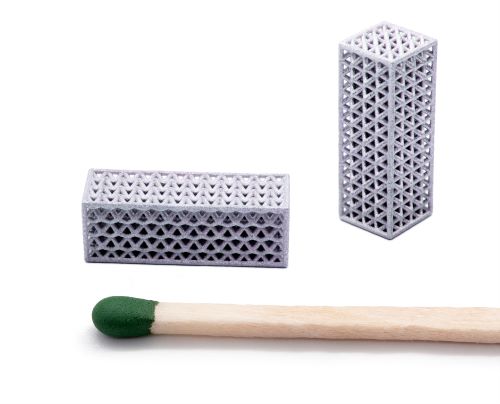High school kids recognize potential of new additive manufacturing technology for the manufacturing of highly complex micro parts
The International Space Station (ISS) offers immense opportunities for industrial and scientific research. Since the year 2000 astronauts use the special conditions such as the presence of permanent microgravity for experiments that provide revolutionizing results.
One of the wide varieties of experiment packages that should be launched in 2023 on the ISS is connected to capillary action in microgravity. This experiment found its starting point at the ISS Research Lab Program at the Valley Christian High School in San José, USA.
For the experiment, the team of students searched for a service provider to manufacture millimetre-scale lattices that were needed for the experiment on capillary action in microgravity. The result of the experiment should give detailed insights on the effect of microgravity on the water-absorbing properties of lattices.
The challenge to find a technology suitable for the production of the lattices with struts as thin as 0.5mm in diameter was bigger than expected as the complex design was not feasible with conventional manufacturing technologies.
This difficulty was the first spark for the students to think outside the box and to lay their eyes on innovative manufacturing methods. Additive manufacturing known as 3D printing received increased attention in the last couple of years and has proven to be an innovative manufacturing technology in multiple industrial sectors. It is especially known for its ability to provide parts with complex designs and therefore the students identified it as a possibility to produce the desired lattices through AM. However, the amount of established and rather new additive manufacturing technologies proposes the challenge to find a suitable technology for the application.
A second challenge that the students needed to deal with is that the material for the lattices needed to match certain requirements as the parts needed to be resistant to vibrations, low temperatures and heat. Moreover, the fact that the design was not printable with conventional metal powder-bed fusion and binder-jetting 3D printing technologies made it necessary to further investigate the possibilities of additive manufacturing.
This, however, did not stop the students to give up their search for a suitable manufacturing technology and therefore the already industrial established micro (stereolithography) SLA technology was identified as a suitable technology to manufacture the lattices as it is known for the ability to provide micro parts with thin structures out of resin. However, as metal was the preferred material to meet all the needed requirements, the students did find another solution. They discovered the potential of the rather new Lithography-based metal manufacturing (LMM) technology, a sinter-based additive manufacturing technology, especially suitable for producing micro metal parts with highest precision. Consequently, they reached out to the American 3D printing service provider, Qualified 3D. They have a partnership with the German start-up, MetShape GmbH and are their exclusive reseller in the US. MetShape is the co-developer of the LMM technology and possesses unique know-how in the handling of the technology which’s starting material is a combination of metal powder and a photosensitive
polymer binder. This so-called feedstock is applied to a building platform and selectively crosslinked from above by means of mask exposure of UV light. Layer by layer, a green part is created. This green part is then debinded and sintered. The LMM technology enables new applications that are currently not economically producible. The advantages of the technology are in particular the high resolution and precision as well as the extraordinary surface quality. It is especially suitable for filigree metal components and parts that have sharp-edged geometries.
Qualified 3D as well as MetShape are delighted that they could support the ISS Research Lab Programme and therefore to contribute to the opportunity to realise an innovative experiment on the ISS.
Subscribe to AM Chronicle Newsletter to stay connected: https://bit.ly/3fBZ1mP
Follow us on LinkedIn: https://bit.ly/3IjhrFq
Visit for more interesting content on additive manufacturing: https://amchronicle.com
Company Press Release


